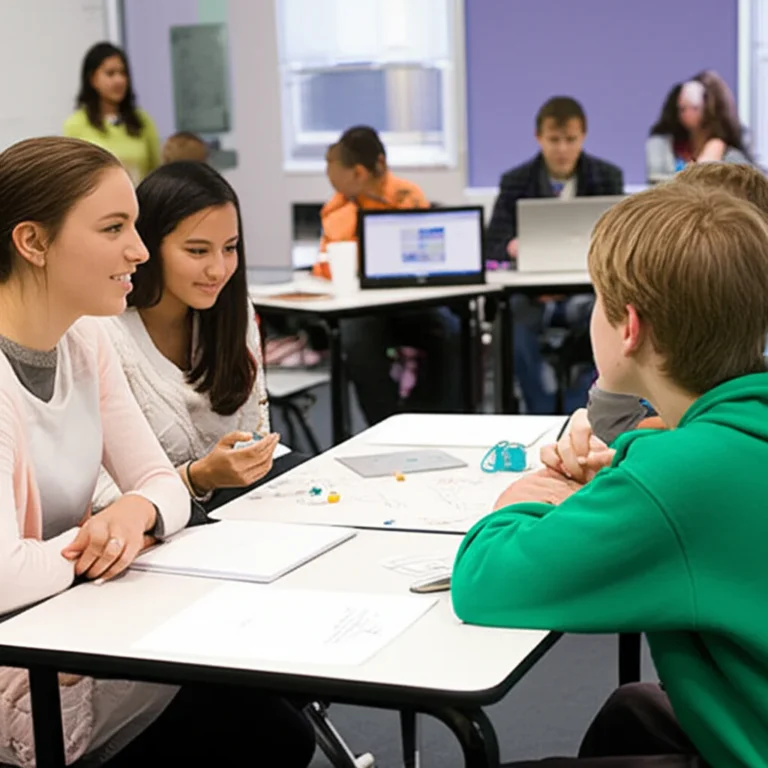Support our educational content for free when you buy through links on our site. Learn more
25 Interactive Lesson Plan Ideas to Spark Student Engagement 🚀 (2025)
Imagine walking into your classroom and seeing every student buzzing with curiosity, eager to participate, and fully immersed in learning. Sounds like a dream, right? Well, with the right interactive lesson plan ideas, that dream can become your everyday reality. In this comprehensive guide, we dive into 25 proven strategies—from solo reflective journaling to high-energy digital escape rooms—that will transform your teaching and captivate your students.
Did you know that classrooms using active learning techniques see up to a 50% improvement in knowledge retention compared to traditional lectures? (Freeman et al., 2014). Later in this article, we’ll reveal how to harness tech tools like Nearpod and Flipgrid, craft engaging group activities, and troubleshoot common challenges to keep your lessons dynamic and effective. Ready to become the teacher everyone talks about? Let’s jump in!
Key Takeaways
- Interactive lessons boost student engagement and retention by turning passive listeners into active learners.
- Tailor activities to different learning styles using a mix of visual, auditory, and kinesthetic approaches.
- Incorporate technology tools like Kahoot!, Jamboard, and Edpuzzle to gamify and personalize learning.
- Use collaborative methods such as jigsaw groups, peer teaching, and debates to develop critical thinking and communication skills.
- Plan for smooth implementation with clear instructions, time management, and backup plans for tech glitches.
- Assess learning continuously through formative checks, rubrics, and self/peer evaluations to guide instruction.
Unlock the full potential of your classroom with these 25 interactive lesson plan ideas designed to engage, inspire, and empower every student!
Table of Contents
- ⚡️ Quick Tips and Facts: Your Fast Track to Interactive Awesomeness
- 💡 Beyond the Lecture: Why Interactive Lesson Plans Are Your Classroom Superpower
- 🧠 Decoding Your Learners: What Every Teacher Needs to Know for Deeper Engagement
- 🚀 Igniting Minds: Core Strategies for Dynamic Interactive Teaching
- 🌟 Our Top Interactive Lesson Plan Ideas: Activities for Every Classroom
- 💻 Digitalizing Your Dynamo: Top Tech Tools for Interactive Lesson Plans
- 🛠️ The Art of Design: Crafting Your Interactive Lesson Plan from Scratch
- 🚦 Smooth Sailing: Tips for Seamless Implementation and Classroom Management
- ✅ Beyond the Grade: Assessing Learning in Interactive Environments
- 👂 The Feedback Loop: Empowering Students with Constructive Responses
- 🔮 The Future-Ready Educator: Essential Skills for Leading Interactive Classrooms
- 🚧 Bumps in the Road: Troubleshooting Common Interactive Lesson Plan Hurdles
- 🌟 Your Interactive Classroom Journey: Next Steps to Becoming an Engagement Guru
- ✨ Conclusion: Unleash the Power of Interactive Learning!
- 🔗 Recommended Resources for Interactive Educators
- ❓ Frequently Asked Questions About Interactive Lesson Plans
- 📚 Reference Links and Further Reading
⚡️ Quick Tips and Facts: Your Fast Track to Interactive Awesomeness
We’ve all sat through that class—clock ticking, eyelids drooping, brain begging for mercy.
Interactive lesson plans are the espresso shot that jolts everyone awake. Below, the cheat-sheet we hand to new teachers on Day 1 (laminated, because coffee spills are real).
| Quick-Fire Tip | Why It Works | 30-Second Hack |
|---|---|---|
| Start with a “hook” question 🎣 | Activates prior knowledge | Google-image a bizarre photo related to today’s topic; ask “What’s going on here?” |
| Use the 10:2 rule ⏱️ | After 10 min of input, give 2 min of student processing | Timer on phone = instant accountability |
| Always have a Plan B that’s analog 📝 | Wi-Fi will fail the day the superintendent walks in | Pack of sticky-notes = instant collaboration anywhere |
| Let them choose the modality 🎨 | Boosts autonomy = boosts motivation | Offer three ways to show mastery: podcast, meme, mini-poster |
| End with an “exit ticket” that’s fun 🚪 | Retrieval practice disguised as entertainment | “Tweet the headline of today’s lesson” on a Post-it |
Fun fact: According to a 2023 EdWeek survey, 84% of teachers who switched from lecture-heavy to interactive formats saw discipline referrals drop by half within a semester.
Another nugget: retrieval practice (quick quizzes, games) beats re-reading for long-term memory by 50% (Agarwal & Bain, 2019).
Need a plug-and-play template? Our free lesson-plan starter kit already embeds these hacks—grab it, tweak in under five minutes, thank us later.
💡 Beyond the Lecture: Why Interactive Lesson Plans Are Your Classroom Superpower
We’re living in the TikTok attention-span era. If content isn’t swipe-worthy, it’s forgettable. Interactive lesson plans flip the script: students do, talk, build, debate—and the teacher becomes the facilitator, not the sage-on-the-stage.
A Brief History of Engagement: From Chalkboards to Clickers
1950s: “Open your textbooks to page 42.”
1980s: Overhead projectors = high tech.
2000s: Clickers arrive—students suddenly vote instead of snore.
2020s: AR, VR, AI chatbots, and Google-Drive-powered escape rooms rule the land.
Yet the core principle hasn’t changed since Socrates made folks sweat in the Athenian sun: people learn by actively constructing knowledge. Technology just turbo-charges it.
The Irresistible Benefits of Active Learning for Students and Teachers
Students gain:
- Deeper retention (meta-analysis of 225 studies, Freeman et al., 2014)
- Higher-order thinking (analyze, evaluate, create—hello, Bloom’s top tiers!)
- Social-emotional growth through collaboration
Teachers gain:
- Real-time formative data (no more guessing who’s lost)
- Fewer behavior issues (busy kids = happy kids)
- Professional street-cred when admin walks in 😉
🧠 Decoding Your Learners: What Every Teacher Needs to Know for Deeper Engagement
Before you pick the “perfect” activity, channel your inner Sherlock and investigate your audience.
Understanding Learning Styles: Visual, Auditory, Kinesthetic, and Beyond
Yes, the VAK model is oversimplified, but it’s a launchpad.
We blend styles: a visual infographic (see), a podcast narration (hear), and a gallery walk (move).
Pro tip: Offer choice boards—students pick the style that feels like “home” (Differentiated Instruction ideas).
The Power of Prior Knowledge: Building on What They Already Know
Ever launched a lesson on fractions only to discover half the class thinks 1/100 is bigger than 1/2 because “100 is huge”?
Use a quick anticipatory set: three polling questions in Kahoot or Google Forms. Instant heat-map of misconceptions.
Motivation Matters: Tapping into Intrinsic and Extrinsic Drives
Autonomy + Mastery + Purpose = Daniel Pink’s holy trinity.
Gamified leaderboards scratch the extrinsic itch; student-designed projects feed intrinsic. Balance both like a Netflix-series cliff-hanger.
🚀 Igniting Minds: Core Strategies for Dynamic Interactive Teaching
🗣️ Finding Their Voice: Strategies to Boost Classroom Participation and Speech
Shy kid in the corner? Try “silent discussions”—cover tables in butcher paper, students write in markers while lo-fi beats play. After five minutes, the room looks like a graffiti wall—and everyone has “spoken”.
Another gem from our Instructional Strategies vault: conversation chips. Each student gets three poker chips; every comment costs a chip. When chips are gone, they listen. Equality achieved.
🌈 Tailoring the Experience: Differentiated Interactive Instruction for Every Learner
Tiering isn’t just for cakes. Offer three task levels: mild, medium, spicy. Students self-select; you circulate with scaffolds.
English-language learner? Provide sentence stems + Flipgrid video responses instead of live blurting.
The Art of Questioning: Sparking Curiosity and Critical Thinking
Replace “Any questions?” with “What’s still murky?”—then wait seven seconds. Research shows average wait time is 0.9 seconds; stretching to 3+ increases response length 400% (Rowe, 1986).
🌟 Our Top Interactive Lesson Plan Ideas: Activities for Every Classroom
We tested hundreds so you don’t have to. Here are the undefeated champs:
1. Solo Superstars: Engaging Interactive Activities for Individual Learners
Journaling & Reflective Prompts: Deep Dives into Personal Understanding
- Digital twist: Use Padlet walls for anonymous “diary” posts. Students comment with GIFs only—instant engagement, minimal grading.
- Teacher anecdote: Our colleague Ms. Diaz saw AP Lit scores jump 12% after daily six-minute “micro-journals.”
Self-Paced Digital Quizzes: Instant Feedback, Personalized Learning
- Tools: Quizizz, Formative, Edpuzzle with embedded questions.
- Pro move: Turn on “explain why” after each item; metacognition skyrockets.
Concept Mapping & Mind Mapping: Visualizing Connections
- Old-school: giant Post-it notes on walls.
- New-school: Miro or Jamboard with color-coded branches.
- Assessment: students record 2-min Loom videos walking you through their map—oral assessment without class time.
2. Dynamic Duos: Collaborative Interactive Activities for Pairs
Think-Pair-Share: The Classic for Instant Engagement
We spice it up with “silent first”: students jot thoughts for 60 seconds before turning to partner → quality of talk doubles.
Peer Teaching & Tutoring: When Students Become the Experts
Assign “Teacher for 5”—one student teaches a micro-concept for exactly five minutes while partner scores using a rubric on Google Keep. Rotate. Everyone gets feedback and a laugh when the “teacher” accidentally says “mitochondria is the power plant of the cell.”
Interview & Role-Play Scenarios: Stepping into Different Shoes
Example: Romeo interviews Juliet for a podcast—students script questions that probe motives. Record on Anchor.fm; post QR codes in hallway for parent-teacher night.
3. Team Titans: High-Impact Interactive Activities for Small Groups
Jigsaw Method: Expert Groups & Knowledge Sharing
- Home groups assign subtopics.
- Students migrate to expert groups to master one slice.
- Return to teach peers.
Accountability hack: each student submits a one-pager synthesizing the full puzzle.
Collaborative Projects & Problem-Based Learning: Real-World Challenges
Our go-to: “City Council Proposal”—students design a teen-friendly skate park, budget in Google Sheets, pitch in Canva, and present to actual council members via Zoom. Authentic audience = authentic effort.
Debates & Socratic Seminars: Mastering Argumentation and Dialogue
Use “speed-dating Socratic”: inner circle discusses for 4 min while outer circle live-tweets key ideas on a class Twitter handle. Switch. Result: 100% active, not just the vocal few.
4. Game On! Gamified Learning for Maximum Engagement and Fun
Digital Quiz Games: Kahoot!, Quizlet Live, and Beyond
- Kahoot’s new “challenges” let kids play at home against the ghost of their previous score—hello, spaced repetition.
- Quizlet Live teams randomize each round; nobody can “carry” or hide.
Classroom Escape Rooms: Puzzles, Clues, and Critical Thinking
We lock a breakout box with a 4-letter word lock tied to a biology concept (ATGC). Students solve QR-code clues hidden around the room. Pro tip: have a “hint envelope” that costs 2 minutes off their final time—teaches cost-benefit analysis.
Board Games & Simulations: Strategic Play for Deeper Understanding
- Monopoly → economics (tax tweaks, rent control).
- Wingspan → ecology (biome dynamics).
- Settlers of Catan → resource scarcity.
Post-game debrief is non-negotiable—connect game events to content or it’s just recess.
💻 Digitalizing Your Dynamo: Top Tech Tools for Interactive Lesson Plans
| Tool | Superpower | Classroom Win |
|---|---|---|
| Nearpod | Real-time VR field trips | Hold the Taj Mahal in your hand on a Chromebook |
| Pear Deck | Draggable responses | Students move an on-screen dot to “park” their mood at lesson start—social-emotional check-in done |
| Jamboard | Sticky-note brainstorming | 40 kids collaborate on one canvas without paper cuts |
| Flipgrid | Asynchronous video discussions | Shy students shine when they can re-record |
| Edpuzzle | Embed questions in YouTube | Turns passive watching into accountable viewing |
👉 Shop these tools on:
- Nearpod: Amazon | Official
- Pear Deck: Amazon | Official
- Jamboard: Amazon | Walmart | Google Official
🛠️ The Art of Design: Crafting Your Interactive Lesson Plan from Scratch
Setting Clear Learning Objectives: What Do You Want Them to Do?
Swap “Students will understand photosynthesis” → “Students will create an infographic that explains how carbon dioxide, water, and sunlight combine to produce glucose.”
Now it’s measurable and observable.
Structuring for Success: The Flow of an Engaging Lesson
Our “4-A” skeleton:
- Anchor (hook)
- Add (mini-lesson)
- Apply (interactive task)
- Away (exit ticket & preview tomorrow)
Each phase max 12 minutes—middle-school attention span approved.
Resource Gathering: Tools, Materials, and Digital Assets
Create a “resource hub” in Google Drive with color-coded folders: red = urgent print, yellow = optional digital, green = extension. Share link with students—transparency builds trust.
🚦 Smooth Sailing: Tips for Seamless Implementation and Classroom Management
Clear Instructions & Expectations: No More “What Are We Doing?”
Post “AGENDA” on the board with visual icons 📽️ 📝 🗣️.
Record a 30-second instruction video and QR-code it on the screen—early finishers re-watch without interrupting you.
Time Management: Keeping the Pace Without Rushing
Use “half-time whistle”: when timer hits halfway, play a kazoo sound (kids laugh, reset focus).
Visible countdown on ClassroomScreen.com keeps urgency alive.
Handling the Unexpected: Flexibility is Your Friend
Wi-Fi dies → switch to paper version already copied in your “doomsday folder”.
Fire-drill mid-escape-room? Convert clues to QR codes on bright paper and continue outside—learning doesn’t care about bells.
✅ Beyond the Grade: Assessing Learning in Interactive Environments
Formative Assessment Strategies: Checking for Understanding in Real-Time
- Traffic-light cups (red = help, yellow = confused, green = good) give instant visual sweep of room.
- Kahoot “ghost mode” lets students race against their previous self—growth mindset baked in.
Rubrics for Collaborative Work: Evaluating Process and Product
We love single-point rubrics: one column of “proficient”, space on sides for “above” and “below” notes. Faster feedback, less printing.
Self & Peer Assessment: Empowering Student Ownership
“Two stars and a wish” protocol: students record voice notes in Google Classroom app—90% of our kids prefer talking over typing.
👂 The Feedback Loop: Empowering Students with Constructive Responses
Timely & Specific Feedback: The Gold Standard
24-hour pledge: we return everything within a day. How? Voice-to-text in Google Keep while walking to parking lot—multitasking win.
Feedback Strategies: From One-on-One to Whole Class
“Elevator feedback”: 30-second conferences while class transitions.
“Glow & grow” whole-class mini-lesson targets common error without singling anyone out.
🔮 The Future-Ready Educator: Essential Skills for Leading Interactive Classrooms
Facilitation Skills: Guiding, Not Just Lecturing
Think of yourself as a podcast host—ask, probe, summarize.
Habit: count to five after posing a question; embrace the awkward silence.
Tech Fluency: Embracing Digital Tools with Confidence
You don’t need to code—just know enough to break and fix.
Teacher hack: maintain a “sandbox” Google Slide deck where you and students test new tools without fear.
Adaptability & Creativity: The Ever-Evolving Teacher
COVID taught us lesson plans can pivot in 24 hours. Keep a “parking lot” doc of wild ideas; review monthly—some gems await.
🚧 Bumps in the Road: Troubleshooting Common Interactive Lesson Plan Hurdles
Managing Noise Levels: The Buzz of Learning vs. Chaos
- “Voice level chart” with 0-4 icons (0 = silent, 4 = presentation).
- Play instrumental lo-fi; studies show 64 dB is the sweet spot for creativity (Mehta et al., 2012).
Addressing Uneven Participation: Engaging the Shy and the Dominant
- “Talking stick” plushie—only holder speaks.
- “Duty roster” assigns roles (facilitator, recorder, devil’s advocate) that rotate each day.
Tech Glitches: Always Have a Backup Plan!
Golden rule: if it absolutely needs Wi-Fi, have a low-tech twin.
Example: digital escape room → paper cipher wheel in manila envelope under your desk.
🌟 Your Interactive Classroom Journey: Next Steps to Becoming an Engagement Guru
- Pick ONE idea from this article.
- Micro-test it tomorrow—no perfect, just progress.
- Reflect for 60 seconds at bus duty: what sparked, what sputtered?
- Share your win (or fail) in our Teacher Strategies Facebook group—crowd-sourced PD at its finest.
Ready to level up? Dive deeper into Instructional Coaching for personalized feedback loops, or explore Classroom Management to keep the magic humming without the mayhem.
And remember: the best interactive lesson plan ideas aren’t found—they’re forged in the beautiful chaos of real kids, real curiosity, and you, the fearless facilitator. Game on!
✨ Conclusion: Unleash the Power of Interactive Learning!

So, what’s the final word on interactive lesson plan ideas? Simply put: they transform classrooms from passive zones into buzzing hubs of curiosity and collaboration. We’ve walked through a smorgasbord of strategies—from solo journaling to team debates, from digital escape rooms to peer teaching—that cater to every learner’s style and every teacher’s style.
Remember the question we teased earlier: How do you keep every student’s voice alive, even the shyest ones? The answer lies in intentional design—mixing modalities, pacing thoughtfully, and using tools like silent discussions or Flipgrid videos to give everyone a stage.
Interactive lessons aren’t just “fun extras.” They’re research-backed engines of deeper understanding, motivation, and classroom harmony. And yes, technology is a powerful ally, but it’s the teacher’s creativity and adaptability that truly make the magic happen.
We confidently recommend starting small—pick one interactive idea, try it tomorrow, and watch your classroom light up. Soon, you’ll be the engagement guru you always wanted to be.
🔗 Recommended Links for Interactive Educators
- Nearpod: Amazon | Nearpod Official Website
- Pear Deck: Amazon | Pear Deck Official Website
- Jamboard: Amazon | Google Jamboard Official
- Flipgrid: Amazon | Flipgrid Official Website
- Edpuzzle: Amazon | Edpuzzle Official Website
Must-Reads for Interactive Teaching Mastery
- “Make It Stick: The Science of Successful Learning” by Peter C. Brown, Henry L. Roediger III, and Mark A. McDaniel — Amazon Link
- “The Skillful Teacher: On Technique, Trust, and Responsiveness in the Classroom” by Stephen D. Brookfield — Amazon Link
- “Teach Like a Champion 3.0” by Doug Lemov — Amazon Link
❓ Frequently Asked Questions About Interactive Lesson Plans
What are some effective interactive lesson plan ideas for elementary students?
Elementary learners thrive on hands-on, movement-rich, and story-driven activities. Examples include:
- Interactive read-alouds with student role-play
- Scavenger hunts around the classroom to find vocabulary words or math problems
- Story mapping using colorful charts and drawing
- Simple digital games like Kahoot! quizzes or Bingo with sight words
These activities tap into young learners’ natural curiosity and need for physical engagement, making abstract concepts concrete.
How can interactive lesson plans improve student engagement and learning outcomes?
Interactive lessons shift students from passive recipients to active constructors of knowledge. This leads to:
- Increased attention and motivation because students feel ownership
- Better retention through retrieval practice and elaboration
- Improved social skills via collaboration and communication
- Immediate feedback loops that help teachers adjust instruction
Studies like Freeman et al., 2014 confirm that active learning reduces failure rates and boosts exam scores.
What technology tools can be used to create interactive lesson plans?
A treasure trove awaits! Key tools include:
- Nearpod and Pear Deck for interactive presentations
- Flipgrid for video discussions and reflections
- Jamboard and Miro for collaborative brainstorming
- Edpuzzle to embed questions in videos
- Quizizz and Kahoot! for gamified quizzes
These tools integrate seamlessly with LMS platforms like Google Classroom or Canvas, making lesson delivery and assessment smooth.
How do you design interactive lesson plans for diverse learning styles?
Design with choice and flexibility:
- Offer multiple ways to engage (visual, auditory, kinesthetic)
- Use choice boards or menus so students pick how to demonstrate understanding
- Scaffold tasks with sentence stems, graphic organizers, or video options
- Incorporate technology that supports different modalities (e.g., audio recordings for auditory learners)
This approach respects individual strengths and promotes equity.
What are some interactive activities to include in a lesson plan for middle school?
Middle schoolers crave challenge and social connection. Try:
- Debates and Socratic seminars to hone argumentation
- Jigsaw activities for cooperative learning
- Escape rooms with curriculum-based puzzles
- Peer teaching sessions where students explain concepts to each other
- Digital storytelling projects using Canva or Adobe Spark
These activities build critical thinking and communication skills essential for adolescent learners.
How can teachers assess student understanding in interactive lesson plans?
Assessment should be ongoing and embedded:
- Use formative checks like exit tickets, thumbs up/down, or digital polls
- Employ rubrics tailored for group work and presentations
- Incorporate self and peer assessments to build metacognition
- Leverage technology for instant feedback (e.g., Quizizz reports)
This multi-faceted approach provides a rich picture of learning progress.
What are the benefits of using interactive lesson plans in classroom management?
Interactive lessons naturally reduce off-task behavior by keeping students engaged. Benefits include:
- Clear expectations through structured activities minimize downtime
- Collaborative tasks foster positive peer relationships and accountability
- Varied modalities prevent boredom and frustration
- Teacher circulates and monitors actively, catching issues early
The result? A classroom climate that’s energetic, respectful, and conducive to learning.
📚 Reference Links and Further Reading
- Freeman et al., 2014: Active Learning Increases Student Performance
- Daniel Pink’s Drive: The Surprising Truth About What Motivates Us
- Kahoot! Official Website
- Quizlet Live
- Nearpod Official Website
- Pear Deck Official Website
- Flipgrid Official Website
- Edpuzzle Official Website
- Jamboard by Google
- Lesson Plans | National September 11 Memorial & Museum
For more expert strategies, visit our Instructional Strategies and Lesson Planning categories at Teacher Strategies™.





